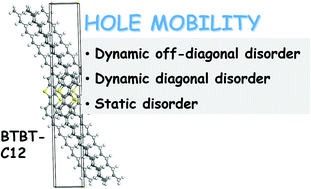Influences of dynamic and static disorder on the carrier mobility of BTBT-C12 derivatives: a multiscale computational study†
Abstract
The role of dynamic and static disorder has been widely discussed for carrier transport in organic semiconductors. In this work, we apply a multiscale approach by combining molecular dynamics simulations, quantum mechanics calculations and kinetic Monte-Carlo simulations to study the influence of dynamic and static disorder on the hole mobility of four didodecyl[1]benzothieno[3,2-b]benzothiophene (BTBT-C12) isomers. It is found that the dynamic disorder of transfer integral tends to decrease the mobility for quasi-1D (quasi one-dimensional) BTBT1 and BTBT4 isomers and increase the mobility for 2D (two-dimensional) BTBT2 and BTBT3 isomers, while the dynamic disorder of site energy tends to decrease mobility for all the four isomers; however, the reduction in 2D molecules is much less than that in quasi-1D molecules. Results show that trap defects could reduce the mobility for both the quasi-1D and 2D molecular structures significantly, even to several orders of magnitude. In addition, our work also reveals that there might exist two kinds of oxidation defects of the scatter type for the concerned isomers, which thus leads to greater reduction in mobility for the quasi-1D molecular structures than the 2D molecular structures. The study shows that the 2D molecular structures are favored over the quasi-1D or 1D molecular structure, and it is expected that these results could be used to shed light on device design in organic electronics.



 Please wait while we load your content...
Please wait while we load your content...